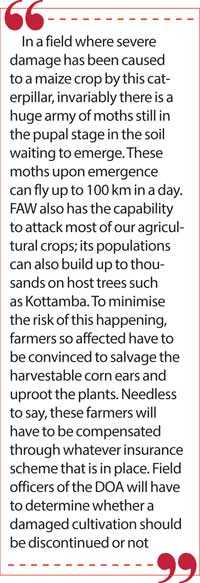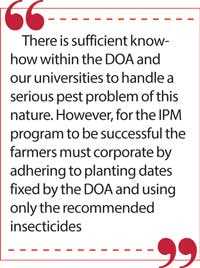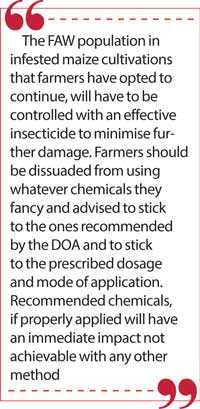Sunday Apr 20, 2025
Sunday Apr 20, 2025
Tuesday, 19 January 2021 00:00 - - {{hitsCtrl.values.hits}}

Unlike most other insect pests, it is polyphagous in the extreme, attacking leaves, stems and reproductive parts of 353 plant species
By Dr. Ivor Fernando
The Fall Armyworm (FAW) recorded for the first time in Sri Lanka in August 2018 on maize is a moth, whose larva (Sena dalambuwa) is one of the most devastating pests of agriculture. It is native to tropical and sub-tropical Americas and has found its way to several African countries in 2016 and then spread to China, Pakistan, India, Nepal, Bangladesh, Myanmar, Thailand and Sri Lanka. 
Unlike most other insect pests, it is polyphagous in the extreme, attacking leaves, stems and reproductive parts of 353 plant species, according to the Commonwealth Agricultural Bureau Int. (CABI). It attacks cultivated grasses like maize, rice, sorghum, sugar cane and wheat as well as cotton and a host of vegetable crops like cabbage, cauliflower, potato, sweet potato, beetroot, silver melon, pumpkin, watermelon, ladies’ fingers (okra), spinach, aubergines, beans, bell pepper, onions, garlic; oil seed crops like sesame, groundnut, sunflower; spice crops like pepper, ginger and chillies, fruit trees like mango, papaya, guava, orange, mandarin and even trees like rubber, eucalyptus and Kottamba (Terminalia catappa).
I have collected egg clusters and larvae of a closely related armyworm from a Kottamba tree in Kadawatha, reared them through to adults and had them identified as Spodoptera mauritia by the Commonwealth Institute of Entomology. Larvae were found on this tree in their thousands and the leaves were riddled with holes due to larval feeding. Since Kottamba is also listed as a host of FAW, there is a great potential for FAW also to multiply to staggering numbers even on a single Kottamba tree! Awareness is important.
According to news reports and TV visuals, the devastation caused by FAW to the Maha season maize cultivations in many parts of the country is alarming. Despite the efforts of the Department of Agriculture (DOA), FAO, university academics and farmers themselves, the armyworm so far appears to be going on the rampage. With an invasive pest such as this, control cannot be achieved overnight due to several reasons. There is no silver bullet, and it is futile to expect parasitoids or predators or viruses or bacteria or any of the botanical pesticides on their own to dramatically bring down the population of this pest. An integrated pest management (IPM) program incorporating the judicious use of recommended pesticides is therefore the best approach.
In IPM, with respect to a given pest on a given crop two important benchmarks have to be established based on the relationship between the pest density and extent of damage caused taking into consideration the economic value of the yield loss at different pest densities and the cost of controlling the pest. These benchmarks are known as the Economic Threshold (ET) and the Economic Injury Level (EIL). They are expressed in terms of number of pests per plant or leaf or unit of ground area or the percentage number of plants infested in a field (determined by sampling, say, 20 plants in a row, the first one being randomly selected and taking the average of several samples).
Say the ET for FAW is determined as 25% of infested maize plants in the field, action should be taken to prevent the value rising to 30% for instance, as then, the farmer will suffer economic loss. IPM aims to prevent or minimise economic loss by taking appropriate action before percentage plants infested exceeds the ET and enters the EIL. IPM makes use of an array of control measures contributing to bring down the pest population below the EIL. The control agents may be parasitoids, predators, viral and bacterial diseases, chemicals both synthetic and botanical as well as cultural measures. It also aims to prevent or minimise adverse effects on human health and the environment.
Important aspects of FAW Biology
The lifespan of the adults is two to three weeks. They mate shortly after emergence. The pre -oviposition period is three to four days. They are strong fliers and capable of flying up to 100km per day. A female moth lays up to 1,000 eggs during its lifetime in 6-10 clusters of 60-300 eggs covered over with greyish brown scales. Egg clusters are found on either surface of young leaves or sometimes on the stem.
Eggs hatch at ambient temperatures around 30 deg. Celsius in two-three days. On hatching the young larvae feed gregariously at first and then scatter and find their way to the leaf whorls. The later instar larvae may show cannibalistic behaviour. Typically, about two larvae may feed at a whorl. There are six larval instars. Heavy mortality occurs in the egg stage and early larval instars due to parasitism and predation by several natural enemies. Later larval instars are voracious and remain hidden in the whorls. The larval period lasts from 14-21 days.
The sixth instar larvae when fully fed may enter the soil and pupate within loose earthen cells and rarely between leaves or on kernels of corn cobs. The pupal cells are found 3-5 inches below the soil surface. The pupal phase lasts from 9-13 days.
Visuals we see daily on TV news about the FAW indicate that, in many places where maize has been cultivated during the Maha season, percentage of plants damaged by this pest is way beyond the Economic Threshold which means that farmers are experiencing economic loss to varying degrees. If effective and decisive action is not taken without delay to make the pest population crash, not only will the farmers suffer considerable economic loss but this pest, when it has finished with the corn will certainly transfer to many of our valuable vegetable and fruit crops. Already, it has been reported that they are found on sugarcane, cabbage and chillies in some areas.
Action suggested
In a field where severe damage has been caused to a maize crop by this caterpillar, invariably there is a huge army of moths still in the pupal stage in the soil waiting to emerge. These moths upon emergence can fly up to 100 km in a day. FAW also has the capability to attack most of our agricultural crops; its populations can also build up to thousands on host trees such as Kottamba. To minimise the risk of this happening, farmers so affected have to be convinced to salvage the harvestable corn ears and uproot the plants. Needless to say, these farmers will have to be compensated through whatever insurance scheme that is in place. Field officers of the DOA will have to determine whether a damaged cultivation should be discontinued or not.
How can the pest population on the uprooted plants and in the soil be impacted? How can the crop residues be disposed of?
This can be done efficiently, profitably and in situ with technology made available under the USAID through a program named ‘SOLID’ project. Crop residues can be efficiently shredded in situ using a contraption manufactured locally, that can be run with electricity or diesel/petrol. The smallest model of this machine shreds 800 kg of plant matter per hour. Simple technology is available to convert the shredded residues into ‘silage’, a high protein fodder fed to high yielding dairy cows. Videos both is Sinhala and Tamil, of this process are accessible on the YouTube. The DOA could play an active role, if they are not doing so already, in converting crop residues into silage and selling this to dairy farmers. The profits made by this project could be used to pay compensation to cultivators who have suffered economic loss due to the ravages of the FAW.
The shredding machine will destroy a major part of the larval population infesting the crop thereby preventing them from pupating and emerging in their thousands to infest other crops. To impact the pupal population lurking in the soil, the field will have to be ploughed as soon as possible after the crop residues are disposed of. Egrets and crows are known to prey on pupae exposed by ploughing.
The FAW population in infested maize cultivations that farmers have opted to continue, will have to be controlled with an effective insecticide to minimise further damage. Farmers should be dissuaded from using whatever chemicals they fancy and advised to stick to the ones recommended by the DOA and to stick to the prescribed dosage and mode of application. Recommended chemicals, if properly applied will have an immediate impact not achievable with any other method. Of the insecticides recommended by the DOA, Chlorantraniliprole (TN. Coragen) ranks first in the scientific literature perused; it is highly toxic to all stages of the target pest including its eggs, has the least mammalian toxicity, is non-toxic to bees, has good residual action both on the plants and the soil and no development of resistance by the pest has been reported so far. Among the other effective insecticides recommended are Spinetoram (TN.Radiant), Spinosad (TN.Success), Emamectin benzoate (TN.Proclaim) and Chlorantraniliproe + Thiamexocam (TN.Virtako).
After harvest, plants must be uprooted, shredded to destroy any stages of the pest remaining in the crop residues and converted to silage. The field should also be ploughed to expose the pupae remaining in the soil, to predators.
Another important rule to observe in the cultivation of maize is the synchronous sowing of seeds by the farmers in a particular area. They must adhere to a planting timetable drawn up by the DOA as late planting has been shown to result in severe pest problems.
 Trap cropping
Trap cropping
Although FAW is polyphagous in the extreme, it has a marked preference for maize and will seek out this crop from far away. This trait may be used to advantage in its control. The strategy is to sow 3-4 small trap plots selected at random from the field, about four weeks before the agreed planting date. The plants in these plots, as they grow will attract most of the FAW within a radius of about 1 km. The gravid females will discharge on average about 1,000 eggs per female, in clusters of about 60-200 eggs on plants, through growth stages VE to about V8. Inspecting the plants, say, at five-day intervals, the freshly laid egg clusters will be clearly visible against the lush green leaves and may be crushed with the fingers as is successfully done on small holdings in many African countries affected by this pest. The larvae can also be hand-picked while the leaf growth is not too dense. However, these plots must be treated with a recommended insecticide to get rid of the stages found on the plants before seeds are sown in the field at large. This is an effective method of minimising the first arrivals of a pest on a crop who are responsible for kick starting the infestation of a crop in its early stages of growth.
Controlling FAW on trees
Fruit trees like mango, guava and orange are also on the menu of this pest. A good biological tool to control this pest is the easily collected predatory ant Oecophylla smaragdina (Dimiya). It has been used in Canton (China) as far back in 300 AD to control lepidopterous pests on orange and mandarin trees. Nests of dimiyas had been sold in the marketplace for pest control purposes. In more recent times Oecophylla was used to successfully control a serious bug pest of coconut (Pseudotheraptus wayi) in Tanzania. Since late 1990s it has been used to control insect pests of cashew in Northern Australia. So, its predatory efficiency has been established and may be used if FAW takes to the tree in Sri Lanka.
Use of natural enemies and diseases in FAW control
A vast number of insect parasitoids and predators belonging to the orders Hymenoptera, Diptera, Coleoptera and Neuroptera are known to attack FAW in all stages of its life history. Insectivorous birds, bats and lizards also play a part in controlling pest populations. Natural enemies of closely related species such as Spodoptera Mauritia and Spodoptera exigua are very likely to have an impact on FAW. Wherever possible, their contribution towards controlling this pest must be enhanced. They are an important constituent of any IPM program. Insect pathogens like Bacillus thuringiensis, Beauveria bassiana and Nucleo polyhedrosis virus are also being tried out as control agents of this pest.
In conclusion, there is sufficient know-how within the DOA and our universities to handle a serious pest problem of this nature. However, for the IPM program to be successful the farmers must corporate by adhering to planting dates fixed by the DOA and using only the recommended insecticides.
(The writer is a retired associate professor of zoology with the University of Kelaniya. He has been teaching and carrying out research in applied entomology for over 35 years. He was also involved in extension work on the biological control of Salvinia in Sri Lanka. He can be reached via [email protected].)
Discover Kapruka, the leading online shopping platform in Sri Lanka, where you can conveniently send Gifts and Flowers to your loved ones for any event including Valentine ’s Day. Explore a wide range of popular Shopping Categories on Kapruka, including Toys, Groceries, Electronics, Birthday Cakes, Fruits, Chocolates, Flower Bouquets, Clothing, Watches, Lingerie, Gift Sets and Jewellery. Also if you’re interested in selling with Kapruka, Partner Central by Kapruka is the best solution to start with. Moreover, through Kapruka Global Shop, you can also enjoy the convenience of purchasing products from renowned platforms like Amazon and eBay and have them delivered to Sri Lanka.
Discover Kapruka, the leading online shopping platform in Sri Lanka, where you can conveniently send Gifts and Flowers to your loved ones for any event including Valentine ’s Day. Explore a wide range of popular Shopping Categories on Kapruka, including Toys, Groceries, Electronics, Birthday Cakes, Fruits, Chocolates, Flower Bouquets, Clothing, Watches, Lingerie, Gift Sets and Jewellery. Also if you’re interested in selling with Kapruka, Partner Central by Kapruka is the best solution to start with. Moreover, through Kapruka Global Shop, you can also enjoy the convenience of purchasing products from renowned platforms like Amazon and eBay and have them delivered to Sri Lanka.